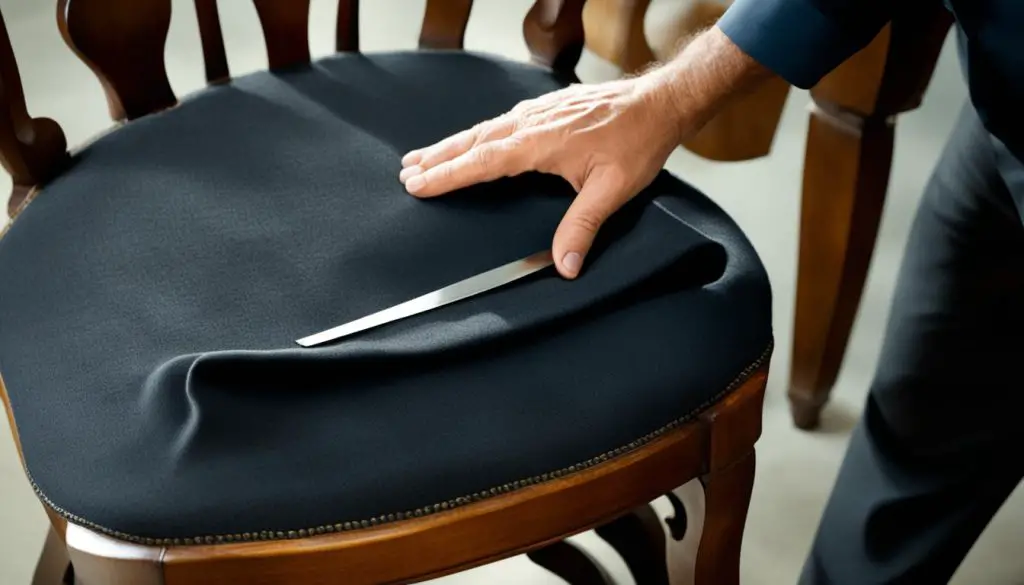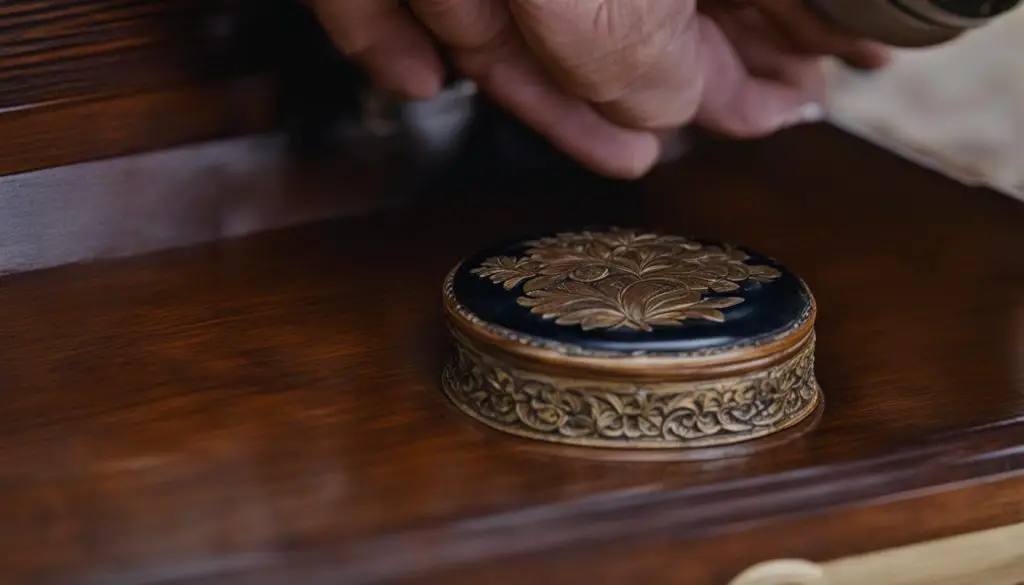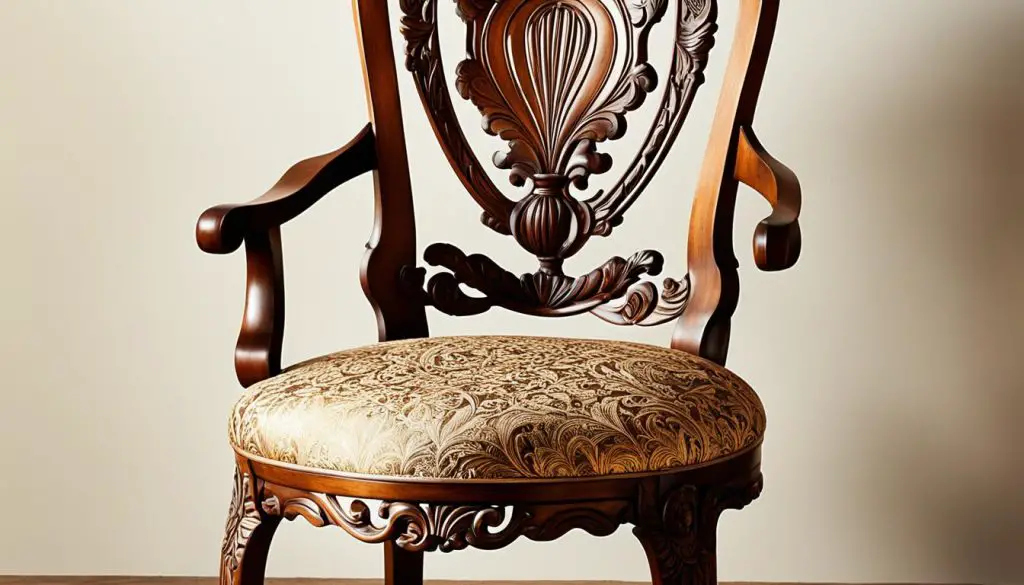Antique wood furniture adds character and elegance to any space, but proper cleaning is essential to maintain its value and beauty. Whether you’ve inherited cherished pieces or found treasures in antique stores, our easy cleaning tips will help you care for these heirlooms.
Key Takeaways:
- Identify the wood finish before cleaning to avoid damage.
- Use mild cleaners and avoid harsh chemicals to protect delicate surfaces.
- Regular dusting and gentle polishing with traditional wax maintain the appearance.
- Take precautions when cleaning different finishes, such as shellac.
- If unsure, consult an expert for professional restoration advice.
Related: How to Clean Upholstered Dining Chairs
Tips for Cleaning Antique Wood Furniture Safely and Effectively
When it comes to cleaning antique furniture, it is crucial to prioritize gentle and safe cleaning methods to avoid damaging these valuable pieces. Harsh chemicals should be steered clear of, as they can strip away the delicate finishes and harm the wood. Instead, opt for mild cleaners and use them sparingly to ensure the preservation of the antique furniture’s integrity.
Here are some essential tips for safe and effective cleaning:
-
Choose mild cleaners:
When cleaning antique wood furniture, it is crucial to select cleaners that are designed for delicate surfaces. Avoid abrasive or chemical-based products that can cause irreparable damage. Opt for mild soaps or cleaning solutions specifically formulated for antique furniture.
-
Use soft and clean cloths:
To prevent scratches and further damage, always clean antique furniture with soft and clean cloths. Microfiber or lint-free cotton cloths are ideal for gently wiping away dust and dirt without scratching the surfaces.
-
Handle difficult stains with care:
If you encounter stubborn stains on antique wood furniture, use more aggressive cleaning methods sparingly and as a last resort. Steel wool can be used cautiously for tough stains, but be mindful of the pressure applied to avoid damaging the wood’s surface.
-
Reach hard-to-access areas:
Toothbrushes are excellent tools for reaching intricate or difficult-to-clean spots on antique furniture. Their gentle bristles can help remove dust and grime effectively without causing any harm.
-
Preserve the brass components:
Antique furniture often features brass accents, such as drawer pulls or decorative elements. It’s important to avoid removing the patina on these components, as it adds character and value to the piece. Simply clean them gently with a soft cloth to maintain their original charm.
-
Consult with an expert:
If you are unsure about the appropriate cleaning methods for a valuable or sentimental antique piece, it is always best to seek the advice of a professional before attempting any cleaning or restoration processes. An expert can provide personalized guidance and ensure that you avoid any costly mistakes.
Remember, when it comes to cleaning antique wood furniture, taking a gentle and cautious approach is crucial to preserving the beauty and value of these cherished pieces.
Maintaining and Polishing Antique Wood Furniture
Preserving the beauty of antique wood furniture requires regular maintenance and proper polishing techniques. To keep your antique wood furniture looking its best, start with regular dusting using a soft cloth. This simple step helps prevent the buildup of dirt and dust that can dull the wood’s finish over time.
When it comes to polishing, using a traditional paste wax is highly recommended. Look for products that contain beeswax or carnauba wax, as they provide a protective coating and enhance the natural beauty of the wood. Liquid polishes are also available for reaching intricate areas that are hard to access.
.

Note: If your antique furniture only requires mild cleaning, regular dusting should suffice. Polish only when grime cannot be removed through dusting or when trying to restore a recently acquired piece.
When applying the wax, take care to follow the manufacturer’s instructions and use gentle circular motions along the wood grain. This technique ensures even application and minimizes the risk of creating scratches or streaks on the surface.
For antique wood furniture with a wax finish, avoid using the soapy mixture mentioned earlier for cleaning. Instead, opt for soap flakes and a damp cloth to gently remove dirt without damaging the wax coating.

Tips for Cleaning Antique Wood with Different Finishes
When it comes to cleaning antique wood furniture, it is essential to understand the specific finishes to ensure proper care and prevent damage. Different finishes require different cleaning methods and products. Here are some valuable tips for cleaning antique wood furniture with various finishes:
Cleaning with Mineral Spirits
If your antique wood furniture has accumulated grime or oily fingerprint stains, mineral spirits can be an effective solution. To clean, follow these steps:
- Apply a small amount of mineral spirits to a clean, soft cloth.
- Gently wipe the cloth along the wood grain, targeting the stained areas.
- Continue wiping until the grime or stains are removed.
- Remember to exercise caution and avoid excessive application, as it may damage delicate finishes.

Dealing with Shellac Finish
Wood furniture with a shellac finish requires special care, as alcohol-based cleaning solutions can cause damage. To determine if your furniture has a shellac finish, perform the following test:
- Apply a small amount of denatured alcohol to a cotton swab.
- Gently rub the swab on a hidden area of the furniture.
- If the finish dissolves or becomes sticky, it is likely shellac.
- In such cases, professional refinishing is recommended to avoid further damage.
- Avoid using alcohol-based cleaning solutions on shellac finishes to prevent stripping the finish.
Conclusion
Cleaning antique wood furniture requires careful attention and a good understanding of the specific finish. Preserving the beauty of antique wood furniture is a rewarding process that can be accomplished by using the right techniques. Regular dusting and polishing with suitable wax products will help maintain its appearance and protect it from damage. Remember to avoid harsh chemicals and abrasive materials that can cause irreparable harm.
Whether you have inherited a stunning antique heirloom or stumbled upon a hidden treasure, taking care of antique wood furniture is essential to its long-term durability and value.
FAQ
How often should I clean my antique wood furniture?
It is recommended to dust antique wood furniture weekly or at least bi-weekly with a soft cloth to maintain its appearance. Deep cleaning can be done as needed or when trying to restore a recently acquired piece.
What should I use to clean antique wood furniture?
Mild cleaners such as oil soap and water are suitable for cleaning antique wood furniture. Harsh chemicals should be avoided, and stronger products should be used sparingly. Soft and clean cloths should be used to prevent scratches.
How do I remove difficult stains from antique wood furniture?
For difficult stains, steel wool can be used as a last resort. Toothbrushes can also be useful for reaching hard-to-reach spots. Exercise caution and test any cleaning methods on a small, hidden area before applying them to the entire piece.
Can I use wax to polish my antique wood furniture?
Yes, traditional paste wax containing beeswax or carnauba wax is suitable for polishing and protecting antique wood furniture. Liquid variants are also available for reaching intricate areas. Only wax an antique if regular dusting cannot remove grime or when trying to restore a recently acquired piece.
How do I clean antique wood furniture with a shellac finish?
Cleaning wood with a shellac finish requires caution, as alcohol can damage it. Perform a test using denatured alcohol and cotton swabs to determine if the finish is shellac. If it dissolves, it requires professional refinishing. Avoid using alcohol-based cleaning solutions on shellac finishes.
What should I do if I am unsure about cleaning my antique wood furniture?
If unsure or dealing with valuable or sentimental items, it is recommended to seek professional restoration or expert advice. Cleaning antique wood furniture can be a delicate process, and it is important to consider the specific needs of different wood finishes to avoid damage.






